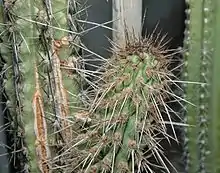| Eulychnia | |
|---|---|
 | |
| Eulychnia castanea | |
| Scientific classification | |
| Kingdom: | Plantae |
| Clade: | Tracheophytes |
| Clade: | Angiosperms |
| Clade: | Eudicots |
| Order: | Caryophyllales |
| Family: | Cactaceae |
| Subfamily: | Cactoideae |
| Tribe: | Notocacteae |
| Genus: | Eulychnia Phil. |
| Species | |
|
Eulychnia acida | |
Eulychnia is a genus of candelabriform or arborescent cacti, comprising between 6 and 9 species depending on the authority. These desert cacti can survive under very hot conditions—temperatures can reach up to 50 degrees Celsius. Furthermore, this breed of cacti can also survive in some of the driest places in the world such as the Atacama Desert, the driest desert in the world.
Species
Wikimedia Commons has media related to Eulychnia.
| Image | Scientific name | Distribution |
|---|---|---|
 | Eulychnia acida Phil. | Chile. |
 | Eulychnia breviflora Phil. | northern Chile. |
 | Eulychnia castanea Phil. | Chile |
| Eulychnia chorosensis P.Klaassen | Chile | |
 | Eulychnia iquiquensis (K.Schum.) Britton & Rose | Chile. |
| Eulychnia ritteri Cullmann | Peru (Arequipa) | |
| Eulychnia taltalensis (F.Ritter) Hoxey | Chile (Antofagasta) | |
| Eulychnia vallenarensis P.C.Guerrero & Helmut Walter | Chile (Atacama) | |
This genus has one synonym: Philippicereus Backeb..
This article is issued from Wikipedia. The text is licensed under Creative Commons - Attribution - Sharealike. Additional terms may apply for the media files.